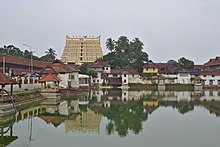Padmanabha swami temple
| Padmanabhaswamy Temple | |
|---|---|
 |
|
| Geography | |
| Coordinates | 8°28′58″N 76°56′37″E / 8.48278°N 76.94361°ECoordinates: 8°28′58″N 76°56′37″E / 8.48278°N 76.94361°E |
| Country | India |
| State | Kerala |
| Location | Thiruvananthapuram |
| Culture | |
| Sanctum | Vishnu |
| Architecture | |
| Architectural styles | Fusion of Kerala Architecture and Dravidian architecture |
| History and governance | |
| Website | Official website |
Padmanabhaswamy Temple is located in Thiruvananthapuram, Kerala, India. The temple is built in an intricate fusion of the indigenous Kerala style and the Dravidian style (kovil) of architecture associated with the temples located in the neighbouring state of Tamil Nadu, featuring high walls, and a 16th-century Gopuram. While the Moolasthanam of the temple is the Ananthapuram Temple in Kasargod, architecturally to some extent, the temple is a replica of the Adikesava Perumal temple located in Kanyakumari District.
The principal deity Vishnu is enshrined in the "Anantha Shayanam" posture, the eternal yogic sleep on the serpent Adisheshan. Sree Padmanabhaswamy is the tutelary deity of the royal family of Travancore. The titular Maharaja of Travancore Moolam Thirunal Rama Varma is the trustee of the temple. In line with the Temple Entry Proclamation, only those who profess the Hindu faith are permitted entry to the temple and devotees have to strictly follow the dress code. The name of the city of Thiruvananthapuram in Malayalam translates to "The City of Lord Ananta", referring to the deity of Padmanabhaswamy Temple.
Several extant Hindu Texts like the Brahma Purana, Matsya Purana, Varaha Purana, Skanda Purana, Padma Purana, Vayu Purana, Bhagavata Purana and the Mahabharata mention this shrine. According to the Bhagavata Lord Balarama visited Phalgunam (more commonly known as Thiruvananthapuram), took bath in Panchapsaras (Padmateertham) and made a gift of ten thousand cows to holy men Though the sannidhyam of Lord Padmanabha has always been present in the holy land of Thiruvananthapuram making it a pilgrim spot even during the time of Balarama, the Temple for the Lord came up much later. The Temple has been referred to in the (only recorded) Sangam Period of literature between 500 B.C and 300 A.D several times. Many conventional historians and scholars are of the opinion that one of the names that the Temple had - "The Golden Temple" - literally was in cognizance of the fact that the Temple was already unimaginably wealthy by that point. Many extant pieces of Sangam Tamil literature and poetry, and even the later works of Ninth Century poet-saints like Nammalwar, refer to the Temple and even the city as having walls of pure gold. At some places, both the Temple and the entire city are often eulogized even as being made of gold, and the Temple as Heaven.
...
Wikipedia
